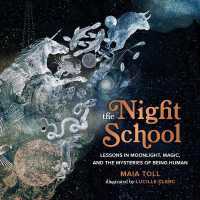- ホーム
- > 洋書
- > 英文書
- > Science / Mathematics
Full Description
Accessible and student-friendly textbook on the astrophysics of stars, now with new observational data and physical concepts
An Introduction to Stellar Astrophysics is a concise textbook containing core content on and detailed examples of stellar physics and stellar astronomy. This new edition is revised and expanded and contains updated and new sections on nearest and brightest stars, the dynamics of double stars, the classification of binary stars, Wolf Rayet stars, and stellar remnants such as white dwarfs.
The book is divided in seven chapters: basic concepts, stellar formation, radiative transfer in stars, stellar atmospheres, stellar interiors, nucleosynthesis and stellar evolution, and chemically peculiar stars and diffusion. Student-friendly features include detailed examples, exercises with selected solutions, brief recalls of the most important physical concepts, chapter summaries, and optional and advanced sections that can be skipped on first reading.
A large number of graphs and figures are included to better explain the concepts covered. Only essential astronomical data are given, and the amount of observational results shown is deliberately limited in scope.
An Introduction to Stellar Astrophysics includes information on:
The electromagnetic spectrum, blackbody radiation, luminosity, effective temperature, the Boltzmann and Saha equations, and the Hertzsprung-Russell diagram
Hydrostatic equilibrium, the Virial theorem, the Jeans criteria, free-fall times, and pre-main-sequence evolution
Radiative opacities, specific intensity and radiative moments, local thermodynamic equilibrium, and radiative transfer at large optical depths
Energy transport in stars, polytropic models, advanced nuclear burning, and novae and supernovae
Diffusion theory, radiative accelerations, and other transport processes
New to this edition: sections on nearest and brightest stars, the dynamics of double stars, the classification of binary stars, Wolf Rayet stars and stellar remnants such as white dwarfs
Delivering intermediate knowledge on stars in a concise format, An Introduction to Stellar Astrophysics is an excellent textbook on the subject for advanced undergraduate and graduate students studying physics and astrophysics.
Contents
Contents
Preface xi
Acknowledgments xiii
Chapter 1: Basic Concepts 1
1.1 Introduction 1
1.2 The Electromagnetic Spectrum 3
1.3 Blackbody Radiation 5
1.4 Luminosity, Effective Temperature, Flux and Magnitudes 8
1.5 Boltzmann and Saha Equations 13
1.6 Spectral Classification of Stars 21
1.7 The Hertzsprung-Russell Diagram 27
1.8 Nearest and Brightest Stars
1.9 Summary 30
1.10 Exercises 31
Chapter 2: Stellar Formation 35
2.1 Introduction 35
2.2 Hydrostatic Equilibrium 36
2.3 The Virial Theorem 40
2.4 The Jeans Criterion 46
2.5 Free-Fall Times† 52
2.6 Pre-Main-Sequence Evolution† 54
2.7 Summary 57
2.8 Exercises 57
Chapter 3: Radiative Transfer in Stars 61
3.1 Introduction 61
3.2 Radiative Opacities 62
3.2.1 Matter-Radiation Interactions 62
3.2.2 Types of Radiative Opacities 64
3.3 Specific Intensity and Radiative Moments 69
3.4 Radiative Transfer Equation 77
3.5 Local Thermodynamic Equilibrium 81
3.6 Solution of the Radiative-Transfer Equation 82
3.7 Radiative Equilibrium 90
3.8 Radiative Transfer at Large Optical Depths 91
3.9 Rosseland and Other Mean Opacities 94
3.10 Schwarzschild-Milne Equations†† 97
3.11 Demonstration of the Radiative-Transfer Equation† 99
3.12 Radiative Acceleration of Matter and Radiative Pressure† 100
3.12.1 Radiative Acceleration of Matter 100
3.12.2 Radiative Pressure 103
3.13 Summary 104
3.14 Exercises 105
Chapter 4: Stellar Atmospheres 109
4.1 Introduction 109
4.2 The Grey Atmosphere 110
4.2.1 The Temperature Profile in a Grey Atmosphere 111
4.2.2 Radiative Flux in a Grey Atmosphere†† 117
4.3 Line Opacities and Broadening 119
4.3.1 Natural Broadening 120
4.3.2 Doppler Broadening 122
4.3.3 Pressure Broadening 130
4.3.4 Stimulated Emission and Masers 132
4.3.5 Einstein Coefficients†† 134
4.4 Equivalent Width and Formation of Atomic Lines 137
4.4.1 Equivalent Width 137
4.4.2 Formation of Weak Atomic Lines 139
4.4.3 Curve of Growth† 142
4.5 Atmospheric Modelling 143
4.5.1 Input Data and Approximations 143
4.5.2 Algorithm for Atmospheric Modelling†† 145
4.5.3 Example of a Stellar Atmosphere Model 148
4.5.4 Temperature-Correction Procedure†† 150
4.6 Types of Binary Stars†
4.7 Summary 151
4.8 Exercises 152
Chapter 5: Stellar Interiors 155
5.1 Introduction 155
5.2 Equations of Stellar Structure 156
5.2.1 Hydrostatic Equilibrium Equation 156
5.2.2 Equation of Mass Conservation 156
5.2.3 Energy-Transport Equation 159
5.2.4 Equation of Energy Conservation 160
5.2.5 Other Ingredients Needed 161
5.3 Energy Transport in Stars 163
5.3.1 Monochromatic Radiative Flux in Stellar Interiors 164
5.3.2 Conduction 166
5.3.3 Convection 167
5.3.3.1 General Description of Convection 167
5.3.3.2 The Schwarzschild Criterion for Convection† 168
5.3.3.3 The Mixing-Length Theory†† 172
5.3.3.4 Convective Equilibrium† 176
5.4 Polytropic Models 176
5.5 Structure of the Sun 182
5.6 Equation of State 184
5.6.1 Introduction 184
5.6.2 The Ideal Gas 185
5.6.3 Degeneracy 189
5.6.4 Radiation Pressure 191
5.7 The Eddington Limit
5.87 Variable Stars and Asteroseismology 191
5.87.1 Variable Stars 191
5.87.2 Asteroseismology† 197
5.87.3 Basic Physics Behind Period-Luminosity Relations† 200
5.9 Summary 202
5.10 Exercises 203
Chapter 6: Nucleosynthesis and Stellar Evolution 205
6.1 Introduction 205
6.2 Generalities Concerning Nuclear Fusion 206
6.3 Models of the Nucleus† 211
6.3.1 The Liquid-Drop Model 211
6.3.2 The Shell Model 214
6.4 Basic Physics of Nuclear Fusion 216
6.5 Main-Sequence Burning 218
6.5.1 Proton-Proton Chains 220
6.5.2 CNO Cycles 221
6.5.3 Lifetime of Stars on the Main Sequence 224
6.5.4 The Solar Neutrino Problem† 226
6.6 Helium-Burning Phase 230
6.7 Advanced Nuclear Burning 232
6.7.1 Carbon-Burning Phase 233
6.7.2 Neon-Burning Phase 234
6.7.3 Oxygen-Burning Phase 234
6.7.4 Silicon-Burning Phase 235
6.8 Evolutionary Tracks in the H-R Diagram 236
6.8.1 Generalities 236
6.8.2 Evolution of Low-Mass Stars (M* _≤ 0.5 M⊙_) 240
6.8.3 Evolution of a 1 M_ Star: Our Sun 241
6.8.4 Evolution of Massive Stars (M* _≥ 10 M_⊙) 245
6.9 Stellar Evolution Modelling†
6.10 Stellar Clusters 248
6.10.1 Stellar Populations, Galaxies and the Milky Way 248
6.10.2 Open Clusters 251
6.10.3 Globular Clusters 252
6.10.4 Age of Stellar Clusters 253
6.10.5 Distance to Stars and Stellar Clusters 255
6.11 Stellar Remnants 257
6.11.0.1 White Dwarfs 257
6.11.2 Neutron Stars, Pulsars and Magnetars 259
6.11.3 Black Holes 262
6.12 Novae and Supernovae† 268
6.13 Heavy Element Nucleosynthesis: s, r and p Processes† 273
6.13.1 The Slow and Rapid Processes 273
6.13.2 The p Process 276
6.14 Nuclear Reaction Cross Sections and Rates†† 277
6.15 Summary 281
6.16 Exercises 281
Chapter 7: Chemically Peculiar Stars and Diffusion† 285
7.1 Introduction and Historical Background 285
7.2 Chemically Peculiar Stars 287
7.2.1 Am Stars 288
7.2.2 Ap Stars 288
7.2.3 HgMn Stars 289
7.2.4 He-Abnormal Stars 289
7.3 Atomic Diffusion Theory†† 290
7.4 Radiative Accelerations†† 297
7.5 Other Transport Mechanisms†† 302
7.5.1 Light-Induced Drift 303
7.5.2 Ambipolar Diffusion of Hydrogen 304
7.6 Summary 305
7.7 Exercises 305
Answers to Selected Exercises 307
Appendix A: Physical Constants 309
Appendix B: Units in the cgs and SI Systems 311
Appendix C: Astronomical Constants 313
Appendix D: Ionisation Energies (in eV) for the First Five Stages of Ionisation for the Most Important Elements 315
Appendix E: Solar Abundances for the Most Important Elements 317
Appendix F: Atomic Masses 319
Appendix G: Physical Parameters for Main-Sequence Stars 321
Appendix H: Periodic Table of the Elements 323
References 325
Bibliography 327
Index 329








